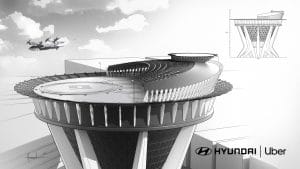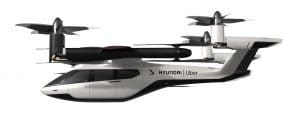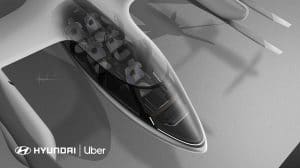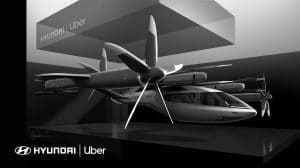Uber is turning to Hyundai to develop, and eventually produce, a line of air taxis for its new Uber Elevate ride-sharing service.
The new partners showed off a full-scale concept at the Consumer Electronics Show in Las Vegas on Monday that is intended to handle trips of up to 60 miles at speeds of up to 180 mph. The planned air cab is part of a broader shift in strategy by Hyundai which now wants to position itself as a “smart mobility solution provider.”
“Our vision of Urban Air Mobility will transform the concept of urban transportation,” said Jaiwon Shin, executive vice president and head of Hyundai’s Urban Air Mobility (UAM) Division. “We expect UAM to vitalize urban communities and provide more quality time to people. We are confident that Uber Elevate is the right partner to make this innovative product readily available to as many customers as possible.”
(Uber hopes to elevate riders with flying taxis)
Uber Elevate is planning to begin demonstration flights this year. The ride-sharing giant hopes to launch commercial service in 2023, with operations initially set to debut in Dallas, Los Angeles and Melbourne, Australia.
Uber Elevate plans to link urban centers and their suburbs, its air taxis expected to handle four or more passengers, flying at altitudes of around 1,000 to 2,000 feet. The company anticipates the roughly 50-mile trip from the Marina district of San Francisco to downtown San Jose, in the heart of Silicon Valley, would take about 15 minutes. By conventional Uber ride-sharing, the same trip can take more than 2 hours, depending upon traffic.
The company already has announced several other potential aircraft suppliers, including Embraer, Bell and Boeing subsidiary Aurora.
Like those partners, Hyundai’s S-A1 “personal air vehicle,” or PAV, uses a fully electric drive system and can take off and land vertically. The multi-propeller PAV functions, in some ways, like the military’s big Osprey in that it transitions, once airborne, to a more traditional aircraft, getting lift from its wings. When set to land, it transition back to eVTOL mode, or electrically powered vertical takeoff and landing.
(Blade Runner 2020? Uber wants to launch flying cars over L.A.)
It remains to be seen how many of the different aircraft manufacturers will eventually
service Uber Elevate, but officials with the start-up operation said that Hyundai has at least one clear advantage.
Hyundai expects to have its aircraft certified and in mass production by 2029 with prototypes in the skies before then.
“Hyundai is our first vehicle partner with experience of manufacturing passenger cars on a global scale,” said Eric Allison, head of Uber Elevate. “We believe Hyundai has the potential to build Uber Air vehicles at rates unseen in the current aerospace industry, producing high quality, reliable aircraft at high volumes to drive down passenger costs per trip.
“Combining Hyundai’s manufacturing muscle with Uber’s technology platform represents a giant leap forward for launching a vibrant air taxi network in the coming years,” Allison added.
The idea of using flying cars has been around for at least a century. Automotive pioneer Henry Ford hoped to develop an airworthy alternative to his Model T, though a fatal crash led him to cancel the program.

Hyundai’s UAM could transport riders from the suburbs into the city, landing on an elevated pad in a fraction of the time it would take to drive.
Traditional helicopters to offer the opportunity for an affluent few to leap over traffic from urban centers, but they are extremely expensive to operate and maintain. Uber is betting electric motors will sharply reduce the complexity – and thus, the cost – of aircraft capable of vertical take-offs and landings. Though it has yet to reveal pricing for the service, it expects its approach will put such a service within the reach of a much broader market.
(Hyundai’s $52B “Strategy 2025” calls for battery cars and “personal air vehicles”)
As for Hyundai, the S-A1 aircraft is part of a broader smart mobility package the company is showing off at CES. That includes a “hub,” the downsized equivalent of a flying taxi air terminal, as well as the PBV, or “purpose built vehicle” that could serve as an autonomous shuttle to carry passengers to and from Uber’s Elevate bases.



